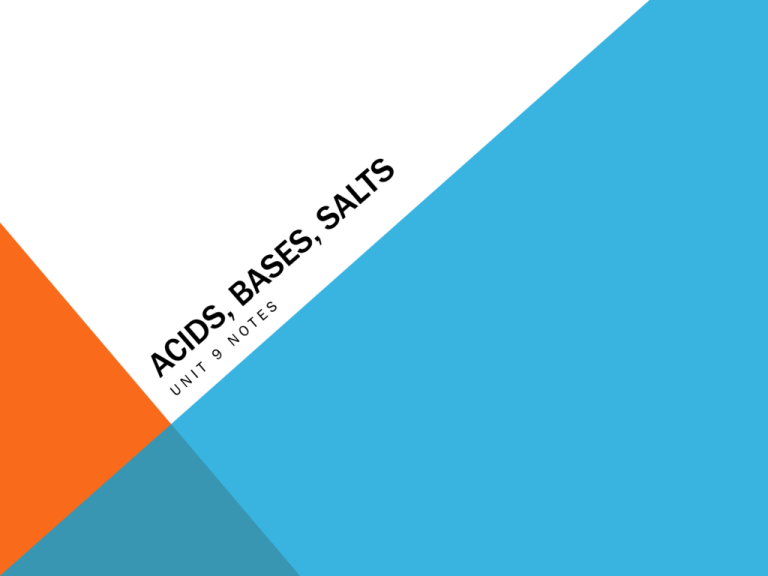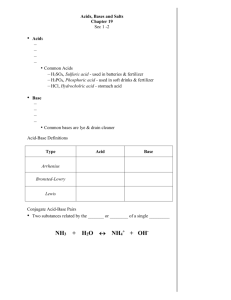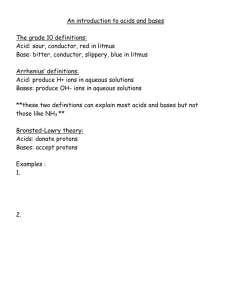Acid and Bases notes
advertisement

An acid is a substance that produces H+ or H3O+ solution. Properties of acids: 1. Sour taste 2. React with certain metals to produce hydrogen gas 3. React with carbonates and bicarbonates to produce carbon dioxide gas 4. Corrode metals 5. React with bases to form a salt and water 6. pH is less than 7 7. Turns blue litmus paper to red “Blue to Red A-CID” 8. Electrolytes- conduct electricity because of ions ACIDS Hydrogen/nonmetal Not in water 1. Hydrogen 2. Name of anion Examples: Formula HCl H 2S HCN not in water hydrogen chloride hydrogen sulfide hydrogen cyanide In water Use prefix “hydro” –root- ic acid in water hydrochloric acid hydrosulfuric acid hydrocyanic acid RULES FOR NAMING ACIDS #1: ACIDS THAT DO NOT CONTAIN OXYGEN HA Hydrogen/polyatomic anion Not in water In water 1. Hydrogen 2. Name of anion Root name then check ending of anion -ite The anion ending changes to –ous acid RULES FOR NAMING ACIDS #2: ACIDS THAT CONTAIN OXYGEN HAOX -ate The anion ending changes to –ic acid EXAMPLES: Formula salt/gas Formula aqueous HNO2 hydrogen nitrite HNO2 (aq) nitrous acid HNO3 hydrogen nitrate HNO3 (aq) nitric acid H2SO3 hydrogen sulfite H2SO3 (aq) sulfurous acid H2SO4 hydrogen sulfate H2SO4 (aq) sulfuric acid H2CO3 hydrogen carbonate H2CO3 (aq) carbonic acid RULES FOR NAMING ACIDS GIVE THE FORMULA FOR THE NAME OR THE NAME FOR THE FORMULA H2 S H2SO3 (aq) HF (aq) HClO2 HIO HNO2 H2SO4 (aq) HI (aq) H2C2O4 (aq) Acetic Acid nitrous acid iodic acid PRACTICE PROBLEMS Acid Formula Where found 1. Hydrochloric HCl stomach, cleaning supplies 2. Sulfuric H2SO4 car batteries, fertilizer 3. Nitric HNO3 explosives, fertilizer 4. Phosphoric H3PO4 detergents, fertilizers 5. Carbonic H2CO3 soda (carbonated) 6. Ascorbic H2C2H6O6 vitamin C (fruits, vegetables) 7. Acetylsalicylic HOOC-C6H4-OOCCH3 aspirin 8. acetic CH3COOH vinegar COMMON ACIDS AND USES The most widely used chemical in the world is sulfuric acid. It can cause severe burns because it is a dehydrating agent. This means that takes all the water out of materials, including skin. A strong acid completely ionizes (breaks apart) in water and releases a lot of H+. Example: sulfuric acid (battery acid) A weak acid only partially breaks down in water, so it doesn’t release much H+. Example: acetic acid (vinegar) STRONG AND WEAK ACIDS A base is a substance that produces OH- solution. Properties of bases: 1.Tastes bitter, chalky 2.Are electrolytes 3.Feel soapy, slippery 4.React with acids to form salts and water 5.pH greater than 7 6.Turns red litmus paper to blue “Basic Blue” BASES Base Formula Where found 1. Sodium hydroxide NaOH soap, lye, drain cleaner 2. Potassium hydroxide KOH liquid soap 3. Barium hydroxide Ba(OH)2 stabilizer for plastics 4. Magnesium hydroxide Mg(OH)2 laxative, antacid 5. Calcium hydroxide Ca(OH)2 mortar, plaster, lime 6. Aluminum hydroxide Al(OH)3 deodorant, antacid 7. Ammonia NH3 cleaners, fertilizer, rayon, nylon COMMON BASES AND USES A strong base completely dissociates (breaks apart) in solution and releases a lot of OH-. Example: sodium hydroxide A weak base does not completely break apart in solution and does not release as much OH-. Example: aluminum hydroxide STRONG AND WEAK BASES There are many ways to consider acids and bases. One of these is pH. [H+] is critical in many chemical reactions. A quick method of denoting [H+] is via pH. By definition pH = -log [H+], [H+] = 10-pH The pH scale, similar to the Richter scale, describes a wide range of values An earthquake of “6” is 10x as violent as a “5” Thus, the pH scale condenses possible values of [H+] to a 14 point scale Also, it’s easier to say pH = 7 vs. [H+] = 1 x 10-7 P H The pH scale is a way of expressing the strength of acids and bases Instead of using very small numbers, we just use the NEGATIVE power of 10 on the Molarity of the H+ (or OH-) ion. pH < 7 = acid pH > 7 = base pH = 7 = neutral P H Indicators: substance that change color in the presence of acids and bases Example: bromthymol blueyellow acid/ blue base/ green neutral phenolthalein- clear acid/ pink base/ light pink neutral phenol red- yellow acid/ pink base/ peach neutral methyl orange- red acid/ yellow base/ orange neutral P H Kw = [H+][OH−] = 1 x 10-14 pH + pOH = 14 pH = - log [H+] and pOH = - log [OH-] (The [ ] means Molarity of H+) Example: If [H+] = 1 x 10-10 pH = - log (1 x 10-10) pH = - (- 10) pH = 10 P H CALCULATIONS 1. If [H+] = 1 X 10-5 pH = - log (1 x 10-5) pH = 2. If the molarity of H+ in a solution is x10 -4, what is the pH? P H CALCULATIONS Calculating [H+] 1. If the pH is 2 what is the [H+] 10 -pH = [H+] [H+] = 2. If the pH is 7 what is the [H+]? P H CALCULATIONS Calculating pOH If [OH-] is 1 x 10 –9 pOH = -log (1 x 10 –9) pOH= P H CALCULATIONS Calculating [OH-] 1. If the pOH is 3, what is the [OH-]? [OH-] = 10 –pOH 2. If the pH is 8, what is the [OH-]? pOH + pH = or [H+] + [OH-] = 1x10-14 pOH= [OH-] = 10-pOH P H CALCULATIONS If you want to neutralize an acid or base, you add a buffer. Buffers are acids, bases, or salts that are mixed with acids or bases to make their pH closer to 7. If you want to neutralize an acid, your buffer must be a base. If you want to neutralize a base, your buffer must be an acid. Buffers in your body help keep your blood’s pH at 7.4. This is necessary because most of your food contains acids. NEUTRALIZATION Neutralization is a chemical reaction between an acid and a base. H+ from the acid combine with the OH- from the base to form water. Metals from the base combine with the nonmetals from the acid to form a salt. Example: HCl + NaOH NaCl + H2O Most salts are formed with a metal and a nonmetal other than oxygen. Some salts are formed with a metal and a polyatomic ion. NEUTRALIZATION Salt formula uses 1. Sodium chloride NaCl food preparation 2. Sodium bicarbonate NaHCO3 baking soda 3. Calcium carbonate CaCO3 chalk 4. Ammonium chloride NH4Cl batteries 5. Sodium phosphate Na3PO4 detergents COMMON SALTS Unpolluted rain typically has a pH value of 5.6, which is acidic, but not harmful. Any rain that is below 5.6 is considered acid rain. Acid rain can: 1. Dissolve marble in buildings and statues 2. Corrode metal (buildings, cars) 3. Kill plankton (then fish die) Ways acid rain can occur: 1. Burning coal releases sulfur sulfur combines with water in the air sulfuric acid forms 2. Car exhaust releases nitrogen oxide Ways to prevent acid rain: 1. “scrubbers” in smoke stacks 2. Nuclear power 3. Cleaner fuel ACID RAIN combines with water nitric acid forms Soaps are organic salts. This means they contain carbon. Soaps are made by reacting fats or oils with sodium hydroxide or potassium hydroxide. Soaps made with NaOH are solids. Soaps made with KOH are liquids. Another product of this reaction is glycerin which is used in lotion. The process of making soap is called saponification. SOAPS, DETERGENTS, AND ESTERS Detergents are similar to soap, but do not form soap scum which is a precipitate that forms when soap is used in hard water (lots of minerals). This is why most laundry products are detergents , not soaps. An ester is an organic compound formed by the reaction of an organic acid with an alcohol. Esters are responsible for the odors and flavors of flowers, fruits, and other foods. Esters are added to jello and candy to give the flavors of strawberry, banana, or apple. Organic acids are also used to make polyester fibers. SOAPS, DETERGENTS, AND ESTERS








